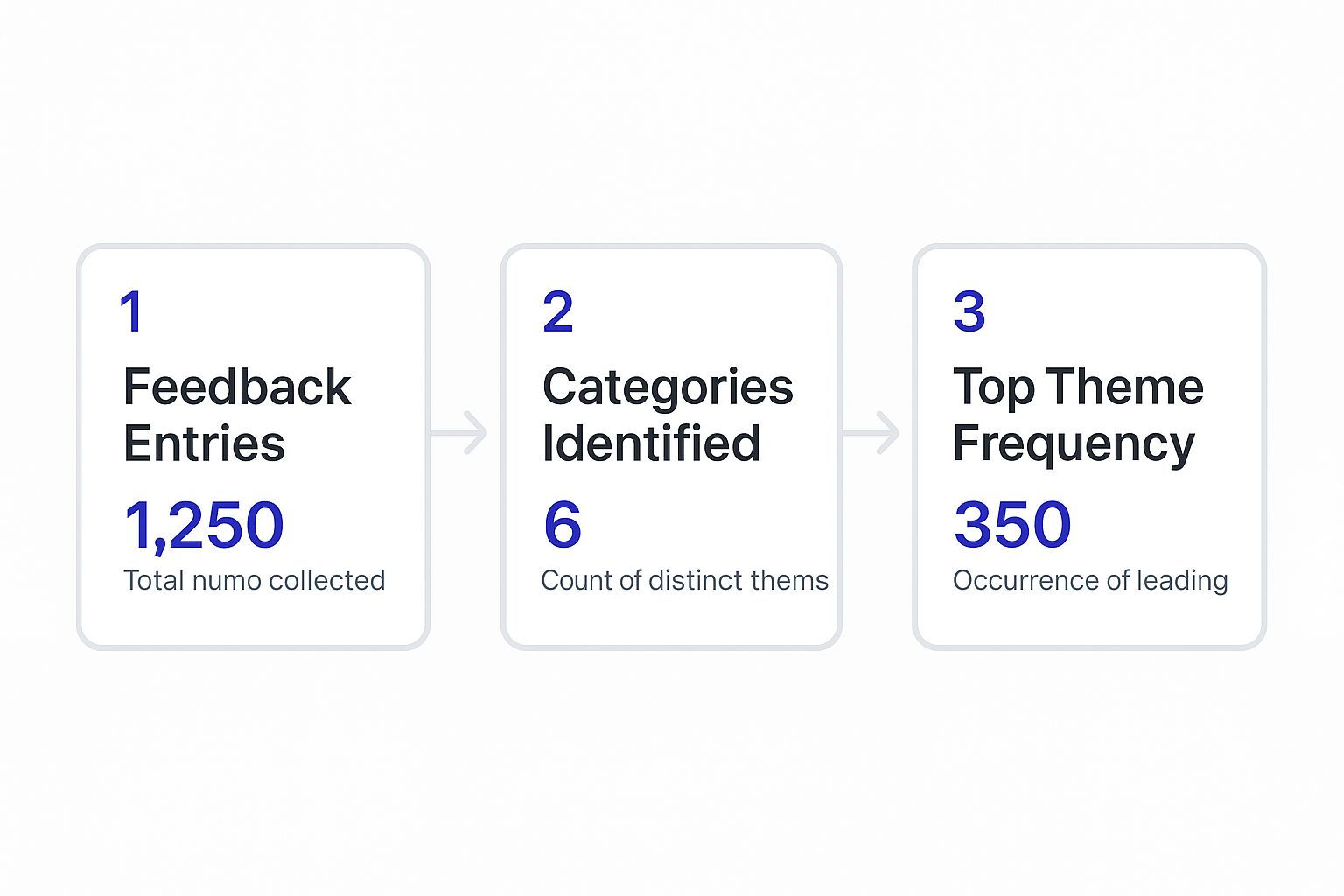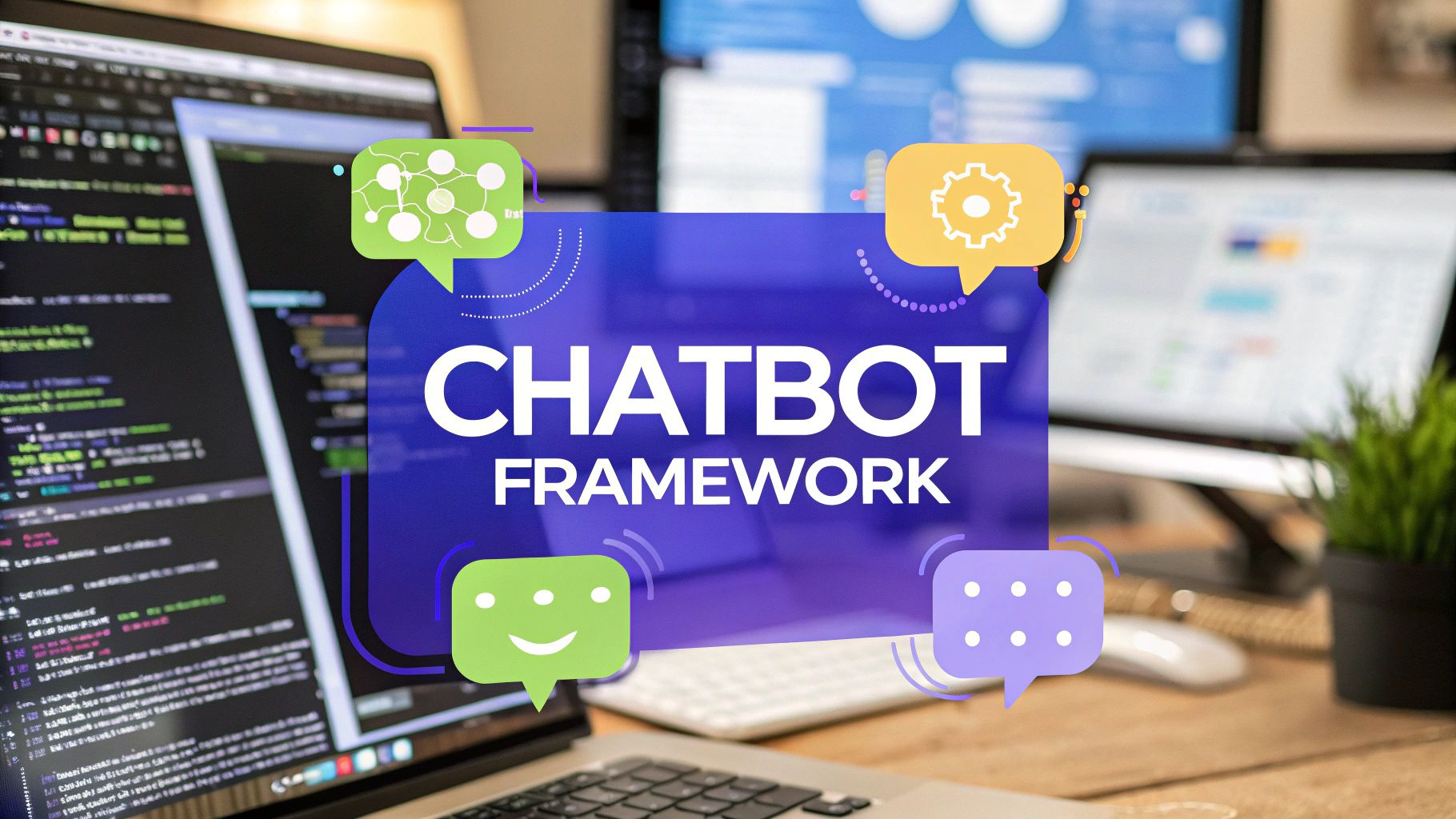Analyzing Customer Feedback for Business Growth
Learn how analyzing customer feedback can transform your business. Discover practical methods to turn customer voice into real growth and lasting loyalty.

Getting customer feedback is one thing. Actually doing something with it is another.
When we talk about analyzing customer feedback, we're really talking about digging into what customers are saying to improve your products and services. The whole point is to stop relying on gut feelings and start using real, hard data to make smart, customer-focused decisions that actually drive growth. It's about turning all those raw comments, ratings, and reviews into intelligence you can act on.
Why Analyzing Customer Feedback Is a Growth Engine

Here's a hard truth: simply collecting feedback isn't enough. Plenty of companies have satisfaction scores and piles of reviews, but that data just sits there, collecting digital dust. The real growth happens when you start digging into that information to understand the "why" behind what your customers do.
This is how you shift feedback from a reactive chore into a strategic part of your business. When you make it the foundation of your planning, you ground every single decision in what actually matters to the people you serve. Suddenly, you're anticipating market changes, innovating ahead of your competitors, and building a brand that people genuinely trust.
Moving Beyond Satisfaction Scores
A high customer satisfaction score can feel great, but it can also be dangerously misleading. It might just reflect a single positive interaction, not a guarantee of long-term loyalty.
In fact, recent research shows a pretty big gap here. While satisfaction levels might look steady, key loyalty metrics like trust and the intent to buy again are often falling. A massive 2025 global study from Qualtrics XM Institute uncovered this exact trend across 20 industries, proving that a happy customer today isn't necessarily a repeat customer tomorrow. This just goes to show how complex loyalty really is and why businesses need to dig deeper than surface-level scores.
The real goal isn't just to keep customers happy with one transaction. It's to build a relationship that makes them choose you again and again, even when competitors come knocking.
This is where a solid analysis process becomes your most powerful tool. It helps you finally connect the dots between what customers say and what they actually do.
The Strategic Benefits of Deep Analysis
When you get into a rhythm of consistently analyzing feedback, you unlock a few key advantages that directly hit your bottom line. These benefits go way beyond just fixing one-off problems; they contribute to a healthier, more resilient business.
Anticipate Customer Needs: By spotting emerging themes in feedback, you can catch trends before they become widespread demands. This gives you a serious head start on product development and service improvements.
Build Customer Trust: Acting on feedback is the clearest way to show customers you're listening. It’s no surprise that 83% of customers feel more loyal to brands that respond to and resolve their complaints. It’s a simple, powerful loop.
Improve Retention: Understanding why customers leave is the first step to stopping it from happening. Feedback analysis uncovers the root causes of churn, letting you put targeted and effective customer engagement strategies in place.
Drive Product Innovation: Your customers are an endless source of incredible ideas. Digging into their suggestions and pain points gives you a clear roadmap for building features they'll actually use and love.
Gathering Feedback That Reveals the Whole Story

To really get a handle on customer feedback, you first need feedback worth analyzing. It’s a simple truth, but one that’s easy to overlook. Not all input is created equal, and if you only listen through one channel, you're only getting part of the story—and a biased one at that.
A modern feedback strategy is all about meeting customers where they are. Forget the generic annual survey. For a SaaS company, that might mean sending a quick in-app prompt right after a user tries a new feature. For a retail brand, it’s about keeping a close eye on Instagram comments and DMs to catch real-time reactions to a new product line.
Balancing Direct and Indirect Feedback Channels
The best insights don't come from a single source. They come from blending what you actively ask for (direct feedback) with the conversations customers are already having on their own (indirect feedback).
Direct feedback is clean, structured, and easy to quantify. It gives you clear answers to specific questions you have. Think of things like:
- Net Promoter Score (NPS) Surveys: These are great for measuring overall loyalty. But the real gold is in the follow-up question: "What's the main reason for your score?"
- Customer Satisfaction (CSAT) Forms: Perfect for getting an immediate pulse check on a specific interaction, like after a support ticket is closed or a purchase is completed.
- In-App Prompts: You can’t beat these for collecting contextual feedback at the exact moment a customer is using a feature or workflow.
On the other hand, indirect feedback is raw, unfiltered, and brutally honest. This is what people say when they don't think you're listening.
Listening to unsolicited feedback is like overhearing an honest conversation about your brand at a coffee shop. It reveals truths that a formal survey might never uncover.
This is where you'll find the candid opinions that truly shape your brand's reputation. Monitoring these channels is non-negotiable if you want the complete picture.
Choosing Your Customer Feedback Channels
To make sense of all the options, you need to match the channel to the type of insight you’re looking for. A quick survey is great for one thing, while a deep dive into Reddit threads is better for another. This table breaks down some common channels and what they’re best used for.
By strategically picking a few channels from this list, you can build a system that captures a much richer, more complete view of what your customers actually think and feel.
Building Your Listening Posts Across the Web
To get that 360-degree view, you have to be present where your customers are talking. This is especially true for younger demographics. For example, a whopping 62% of Millennials turn to unofficial sources like Reddit and YouTube to solve problems before they even think about contacting support, according to a report on Nextiva.com.
This trend says a lot. It shows a clear preference for self-service and community knowledge, making these platforms vital listening posts for any brand.
Your listening strategy should include a mix of these key sources:
- Social Media Mentions: Use a tool to track every time your brand is mentioned on platforms like X and LinkedIn.
- Online Review Sites: Keep a close watch on G2, Capterra, Google Reviews, and any other sites that matter in your industry.
- Community Forums and Reddit: Don't just look for your brand name. Search for threads about your competitors or the problems your product is built to solve.
When you combine direct survey data with these indirect sources, you stop just collecting scores and start building a real intelligence system. This approach doesn't just help you improve your product—it’s also a critical way to understand the warning signs that reduce customer churn long before it's too late.
You’ve collected a mountain of feedback—now what? This is the point where raw comments, ratings, and survey responses start to become a real source of business intelligence. Moving from collection to analysis is how you stop guessing what customers want and start knowing.
The goal is to transform that messy, unstructured data into clear, understandable insights. This process isn't about complex statistics; it's about systematic organization. Whether you use a simple spreadsheet or a dedicated tool, the principles are the same.
The Power of Thematic Analysis
The first and most important technique in your toolkit is thematic analysis. I like to think of it as sorting a huge pile of mail into labeled bins for bills, letters, and junk mail. You’re simply grouping individual pieces of feedback into broader categories or "themes."
For instance, you might notice multiple comments mentioning slow loading times, broken links, and confusing navigation. Instead of treating these as three separate problems, you can group them under a single, powerful theme: “Website Usability Issues.”
This simple act immediately elevates specific complaints into a larger, more strategic issue that the business can actually tackle.
This visual shows a simplified flow of how raw entries are distilled into meaningful themes that you can act on.

This process reveals not just what the issues are, but also how often they come up, helping you prioritize what to fix first.
Uncovering the Why with Root Cause Analysis
Once you've identified a major theme, the next job is to dig deeper. A root cause analysis helps you move beyond the symptom to find the underlying disease. It’s all about repeatedly asking "why" until you uncover the core problem.
Let's say your thematic analysis highlights a spike in negative feedback around "delivery issues." This is the symptom.
- Why are deliveries an issue? Customers report their packages are arriving late.
- Why are they arriving late? You check the tracking data and see the delays are all in a specific region.
- Why are they delayed in that region? You remember you recently switched to a new, cheaper courier for that area.
Suddenly, you've moved from a vague theme to a concrete, solvable problem: an underperforming shipping partner. This is the essence of effective feedback analysis—it connects a customer's complaint directly to a specific business operation.
A critical mistake is stopping at the surface level. Identifying a theme like 'poor customer service' is only half the job. The real value comes from discovering why the service is poor—is it inadequate training, understaffing, or faulty software?
Gauging the Mood with Sentiment Analysis
Alongside identifying themes, you also need to understand the emotional tone of the feedback. Sentiment analysis is the process of classifying feedback as positive, negative, or neutral. It adds a crucial layer of context to your data.
While powerful AI tools can automate this, you can absolutely start manually. A simple three-column system in a spreadsheet—Positive, Negative, Neutral—is all you need to get going.
This is especially useful for tracking changes over time. For example, did sentiment around your mobile app’s checkout process turn negative right after the latest update? Combining sentiment with thematic analysis gives you a rich, multi-dimensional view of the customer experience.
By tracking these emotional currents, you can spot problems before they escalate and recognize what you’re doing right so you can do more of it.
Finding the Right Tools for Your Feedback Stack

If you’re just starting out, manually sorting feedback in a spreadsheet is a rite of passage. But let's be honest—it doesn’t scale. As your business grows, so does the flood of customer opinions, and that spreadsheet quickly becomes a bottleneck.
To keep up, you need technology that can actually handle the volume and complexity of modern customer feedback. This is where a well-chosen "feedback stack" comes into play. The right tools for analyzing customer feedback will automate the tedious work of sorting and tagging, freeing up your team to focus on finding those game-changing insights.
They can connect data from surveys, reviews, and support tickets into one place, revealing patterns you’d never spot otherwise. This is how you turn feedback analysis from a once-a-quarter project into a continuous, real-time operation.
All-in-One Platforms vs. a Custom Stack
Your first big decision is whether to go with a single, all-in-one platform or build a custom stack of specialized tools. Each path has its own trade-offs.
An all-in-one suite like Qualtrics or Medallia offers an integrated environment for everything from survey creation to advanced analytics. This simplifies vendor management and keeps all your data under one roof—a huge plus for enterprise-level teams that need consistency and broad functionality.
A custom stack, on the other hand, is about piecing together best-in-class tools for specific jobs. For instance, you could use a dedicated survey tool, pull social media mentions from another, and feed it all into a specialized text analysis tool like MonkeyLearn or a platform like Chatiant for AI-powered summarization. This approach gives you more flexibility and often more powerful features for each specific task.
A custom stack gives you the freedom to choose the absolute best tool for each part of the feedback analysis process. While it requires more integration effort, this approach can give you a significant competitive edge by using more powerful, specialized technology.
Choosing the Right Path for Your Team
So, which way should you go? The decision really comes down to your team’s specific needs, budget, and technical comfort level. There’s no single “best” answer, only the one that fits your reality right now.
Here’s a quick way to think about it:
Go with an all-in-one platform if:
- You have a large, cross-functional team that needs a single source of truth.
- You value simplicity and unified reporting over niche, specialized features.
- Your budget can handle a higher, single-platform investment.
Build a custom stack if:
- You're a more agile team that wants to use the most powerful tools available for each task.
- You have some technical resources to manage integrations between tools (or can use tools that easily connect).
- You want to start small and add new tools as your analysis program matures.
Investing in technology isn’t just about making things more efficient; it’s about deepening your ability to truly understand your customers. Whether you choose a single suite or build a custom stack, the goal is the same: to create a system that turns customer voices into your most valuable strategic asset.
Closing the Loop and Driving Real Business Impact
Collecting customer feedback is just the start. A brilliant analysis that gathers dust on a shelf doesn’t help anyone. The final—and most critical—part of the process is turning those hard-won insights into real business action. This is where you create a closed-loop system that gets the right information to the teams that can actually do something about it.
This whole process transforms feedback from a passive report into an active engine for continuous improvement. It’s all about building clear pathways so the voice of the customer directly influences your operations, product development, and even your marketing. When you close the loop, you’re not just listening—you’re proving it.
Routing Insights to the Right Teams
Your analysis will almost always uncover different kinds of issues that need attention from different parts of your company. That’s why creating a simple routing plan is essential to make sure nothing falls through the cracks. It’s about connecting the problem to the problem-solvers.
For instance, a sudden spike in negative comments about a confusing checkout flow shouldn't just sit in a report. It needs to land directly in the lap of the UX and product teams, triggering an immediate review of that user journey.
Think of it this way:
- Product Teams: Get all the feedback on feature requests, bugs, and usability headaches. This becomes direct, unfiltered input for their development roadmap.
- Marketing Teams: Need insights on brand perception, how campaign messaging is landing, and what people are saying about competitors. This helps them fine-tune their strategy.
- Support & Operations Teams: Are alerted to service gaps, agent performance issues, and process bottlenecks. On the flip side, glowing reviews about a specific support agent can become the new gold standard for your training program.
From Feedback to Actionable Projects
Once the insights are with the right people, the next move is to translate them into concrete projects. A vague theme like “customer confusion” isn’t something a team can act on. You have to break it down into specific tasks with clear ownership.
If your analysis flags a theme of "difficult onboarding," the action isn't just "improve onboarding." It's a series of smaller, manageable projects:
- Task: Redesign the initial setup wizard to include more in-app guidance.
- Task: Create a new series of short tutorial videos for first-time users.
- Task: Update the help center with a dedicated "Getting Started" section.
This approach turns a high-level finding into a focused plan that teams can actually execute, measure, and complete. To get more ideas on streamlining these workflows, check out our guide on improving customer service efficiency.
The High Stakes of Inaction
Ignoring feedback, especially when it comes to the quality of your service, comes with a steep price. Customers today have endless choices and very little patience for bad experiences. The quality of those interactions has a direct, and often immediate, impact on loyalty.
Research from Salesforce reveals a stark reality: 57% of customers will switch to a competitor after just a single bad experience.
That number alone should light a fire under any business. It highlights just how urgent it is to create a responsive feedback loop. When customers feel unheard, they don't just get frustrated—they leave. You can dig into more data on this and explore the full impact in this customer experience report.
Ultimately, closing the loop is what gives your entire feedback analysis program its purpose. It's the engine that prevents customer churn, fuels smart innovation, and builds an unbeatable edge based on what your customers actually want.
Of course, even with a solid game plan, you're bound to run into a few questions once you start putting a feedback analysis program into practice. Let's tackle some of the most common hurdles teams face right out of the gate. Getting these right will help you build a system that actually works.
How Often Should We Actually Analyze This Stuff?
The honest answer? It depends entirely on how much feedback you’re getting.
If you have high-traffic channels like post-chat surveys or a busy social media presence, you’ll want a near real-time pulse check. This is where automated tools really shine, letting you jump on urgent issues the moment they pop up.
But for things like quarterly Net Promoter Score (NPS) surveys, a weekly or bi-weekly review is perfectly fine. The key is to find a consistent rhythm so insights never go stale. If you're not sure where to start, a weekly review is a great baseline. You can always adjust from there once you see the data flow and how quickly your team can act on it.
What's the Single Biggest Mistake People Make?
This one’s easy: focusing only on the numbers. Too many teams get hung up on a specific NPS or CSAT score without ever digging into the comments that explain the why behind it. A score tells you what happened, but the open-ended feedback tells you the story.
Ignoring qualitative insights is like reading a book's cover but never opening it. You miss the entire plot. A successful feedback program has to weave together both the metrics and the themes to give you a complete, actionable picture of the customer experience.
How Can a Small Business Get Started Without Fancy Tools?
You absolutely do not need an expensive enterprise platform to get going. The best approach is to start small and focused. Pick one or two high-impact channels, like your Google Business Profile reviews or a simple post-purchase email survey.
From there, a spreadsheet is your best friend. Seriously.
Just create a simple system to manually track and categorize what you find. All you need are a few columns:
- Date the feedback came in
- Source (e.g., Google Review, email)
- Sentiment (Positive, Negative, Neutral)
- Theme (e.g., 'Product Quality,' 'Shipping Speed')
Even doing this consistently once a week will start revealing powerful patterns, all without a major investment.
What Do We Do with Contradictory or Biased Feedback?
It’s tempting to overreact to a single, fiery comment, but the real power of analysis comes from looking for trends, not outliers. Every single business gets biased or contradictory feedback. It's just part of the game.
Your job is to separate the signal from the noise.
If one person complains about a feature that fifty others are raving about, it’s probably an isolated opinion that doesn't need immediate action. But if you start seeing a theme of complaints emerge—even from a small but growing group—that’s a signal worth investigating. Use volume and recurrence as your guide to focus on the issues that are impacting a meaningful slice of your customer base.
Ready to turn customer feedback into your most powerful asset? The AI agents from Chatiant can automatically analyze, categorize, and summarize feedback from any source, giving you actionable insights in real-time. Train a custom AI assistant on your data today.


